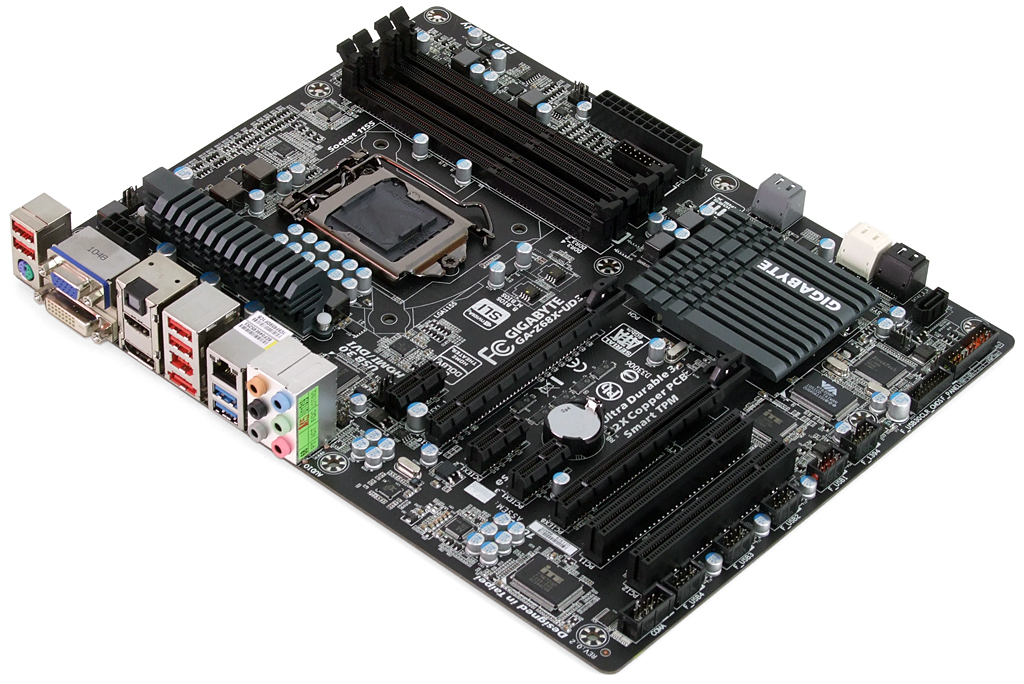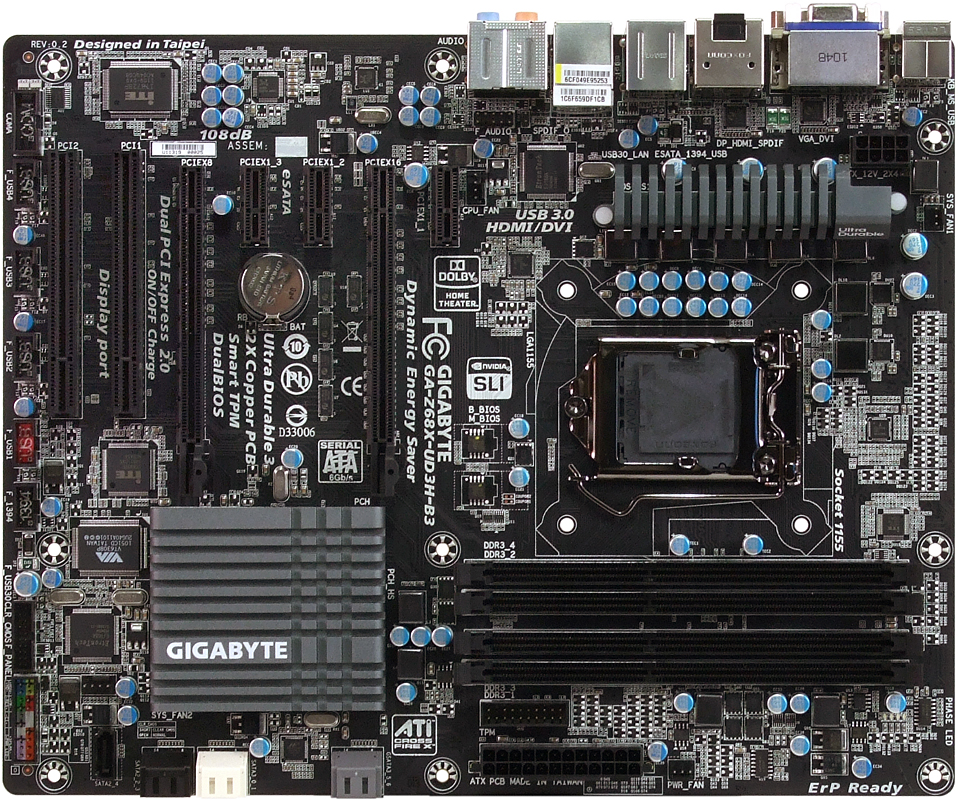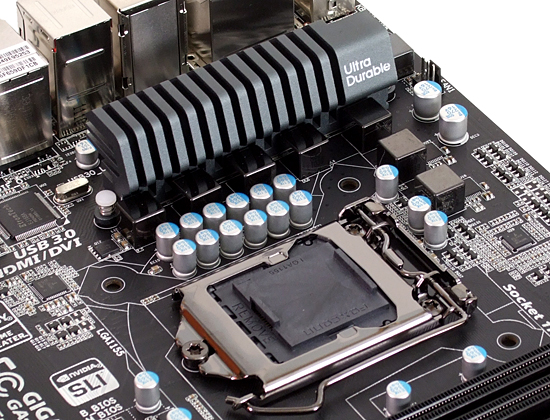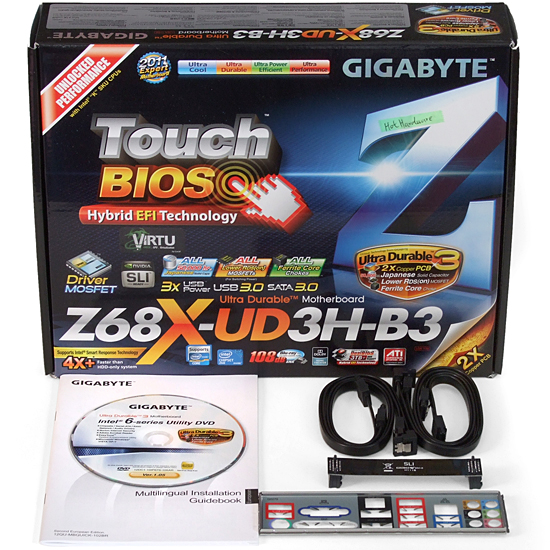Z68 Express Roundup: Three Motherboards Do Battle Around $200
Intel reserved its most feature-rich LGA 1155 platform for (or four?) months past the launch of its Sandy Bridge-based processors, but was it worth the wait? We compare three upper-mainstream Z68 examples to a top-quality P67 predecessor to find out.
Gigabyte Z68X-UD3H-B3
Let it be known that pre-B3 stepping Z68 chipsets (ones without the now-famous Cougar Point SATA bug) never made it to the market. With that noted, one of the distinguishing features of Gigabyte’s long model number is no longer relevant. With that aside, there’s plenty to like about Gigabyte’s GA-Z68X-UD3H-B3 (henceforth abbreviated as Z68X-UD3H).
For example, many readers have likely noticed by now that those rear-panel video connectors eat away at available back-panel space, forcing ASRock to eliminate USB ports and Asus to eliminate PS/2. At first, Gigabyte looks more like ASRock in this regard, but addresses the lack of external ports by adding more internal ports. An incredible eight USB 2.0 ports (four headers) and two USB 3.0 ports (one header) are available internally, to be connected to front-panel devices or slot brackets.

Gigabyte does not use an add-in controller for eSATA, but instead redirects one of the Z68 chipset’s SATA 3Gb/s ports to the I/O panel. That reduces the integrated controller to five ports, but allows users who don’t need more than five internal ports to disable any third-party controllers without disabling eSATA. Users who need up to seven internal ports will still find two internal ports on a third-party controller, though RAID arrays on separate controllers can’t be combined.
In other words, Gigabyte’s design makes sense for the majority of the Z68X-UD3H’s target market. Buyers with more exacting needs will likely seek a more expensive product anyway.

Similarly, Gigabyte eliminates Asus’ PCIe lane sharing problem not by adding a PCIe bridge, but by getting rid of the four-lane slot Asus and ASRock place at the bottom of their boards. Asus’ solution can’t be used in x4 mode without disabling several onboard controllers, and ASRock’s addition of the PCIe bridge makes it a more expensive product. Gigabyte and ASRock are probably at opposite ends of the $150-200 market when it comes to production cost, yet the only real difference most builders notice is the lack of support for a third graphics card.

In fact, the only cost-saving measure that really concerned us was Gigabyte’s seven-phase voltage regulator. Gigabyte is one of the few manufacturers who hasn’t received a nasty email from us concerning flaming voltage regulation circuitry. But even a well-protected circuit will become unstable (or shut down) when pushed beyond the limits of its components. That is to say, our chief concern is whether or not this reduced-cost design can take our processor anywhere close to its 4.7 GHz limit at 1.35 V.

The Z68X-UD3H installation kit contains four SATA cables, a flexible SLI bridge, an I/O panel plate, a manual, and the software CD.
Get Tom's Hardware's best news and in-depth reviews, straight to your inbox.
-
Crashman user 18ASrock comes with 4 eSATA cables?KisakukuThe first UEFI screenshots for ASRock and Asus are switched.Fixed, thanks!Reply -
evga_fan ->ThomasReply
"Gigabyte’s Quick Boost application sets our processor at 200, 400, or 700 MHz beyond its rated frequency."
Just so you know. Anyways, keep up the good work!
Cheers -
crisan_tiberiu so, basicaly there is no difference in performance between theese boards as i can see.Reply -
hmm .. was thinking of getting an Asus P8Z68-V Pro .. not so sure now knowing that the other boards offer the same performance and are both cheaper.Reply
-
Olle P One additional feature of the ASRock card that isn't mentioned is its set of holes matching a socket 775 cooler. That feature was the main reason I ordered one of these cards three days ago, since I won't have to spend money on a new CPU cooler.Reply -
crisan_tiberiu Olle POne additional feature of the ASRock card that isn't mentioned is its set of holes matching a socket 775 cooler. That feature was the main reason I ordered one of these cards three days ago, since I won't have to spend money on a new CPU cooler.Reply
ermm thats pro, since i have a socket 775 core 2 duo atm. Any other motherboards out there that suport this?? i would love to know
